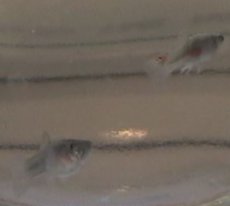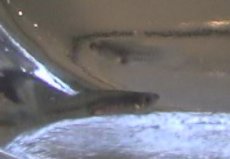 |
 |
|
|
Last Updated: 2/28/14


Quick Information
Description
Setup and Water Preferences
Sexing
Breeding
Links
My Guppies

Common names: Guppy, Millions Fish
Scientific/Latin names: Lebistes reticulatus, Poecilia
reticulata
Maximum length: Males 0.5 to 1.5 inches, females 1.5 to 2.5 inches
Colors: Red, blue, yellow, black, white, gold, green, and many more
Temperature preference: 65 to 75 degrees F, can withstand about 50 to 100
degrees F (60 to 90 for fancy varieties)
pH preference: 7 to 8.5
Hardness preference: Moderate to hard
Salinity preference: 1 Tablespoon per 3-5 gallons
Compatibility: Good but prone to chasing and nipping same and other
species, voracious eaters of egg-laid fry
Life span: 2 to 5 years
Ease of keeping: Easy if water is not too soft or low in salts
Ease of breeding: Easy

Lebistes reticulatus or Poecilia reticulata, the guppy, has been bred into dozens of colors and varieties. They keep on changing the Latin name. Just like goldfish and koi, the guppy is a show fish. Wild guppies are nothing to jump up and down about. Females are just a brownish gray. Males have some spots of red, blue, etc. but may also be plain. Some can be rather pretty. Native to parts of Central and South America, the native guppy is also called the Millions Fish. This is because it breeds so well. Fancy guppies can have any combination of reds, yellows, golds, silvers, blues, purples, oranges, greens, blacks, browns, and/or whites. Most guppies stay at about 1-1.5 inches long but they can grow to 2.5 inches. Guppies do chase each other and other fish but generally do no harm. They are considered relatively peaceful. They will however eat newly hatched fry of most species. Some other species of fish may nip at fancy guppies' fins. A few gallons per guppy is adequate. They generally live a few years. Guppies tend to stick to the upper region of an aquarium.

Guppies need moderate hardness, some added salt (one Tablespoon per five gallons) especially if the water is soft, and a slightly basic pH (7-8.5). They can survive, at least for a while, in almost any water. Ordinary guppies thrive from 50 to 90 degrees F while fancy guppies do best between 65 and 85 degrees F. Be sure to provide lots of plants in which the females and fry can hide. Guppies like fine leafed plants like cabomba and a dark gravel bottom. They need at least a few gallons a piece. They eat most anything but prefer live insect larvae and fry.

Guppies can mature by three months. Males are generally smaller, but often longer finned. Mature females are full bodied and have a gravid spot which is a dark spot near their vent. Males are much more colorful. They also have a gonopodium which is a modified fin which delivers sperm into the female.

Keep a few females with a male. He will impregnate the females. Guppies are usually able to first breed by the age of three months. One mating can fertilize several batches of live-born fry. After breeding, the babies develop over one to two months depending on water temperature and the health of the mother. She can give birth early or delay birth depending on her health and stress level. She can also store sperm for many months to use it later (called superfoetation). It is common for newly bought female guppies to give birth months after being obtained even when kept in a tank devoid of males.
Females have a gravid spot which is a dark spot near their vent. As her young grow, her abdomen will become larger and larger. When you can see a large dark mass near her vent and she appears ready to pop, she is nearing delivering. A female ready to release fry may appear afraid and hide in the plants or dart about the tank. Place her in a breeding box or a small tank by herself with lots of floating and other live plants. Stores sell a number of plastic breeding boxes for guppies. In breeding boxes, the newborns fall below a grate so that the female cannot eat them. Alternatively, provide a lot of plant cover and some fry should survive by hiding. Remove the female to either her normal tank or a small quiet tank to herself after she has finished delivering. Do not keep her in a breeding box for long since the stress can kill her. Do not put her in a breeding box too early or she can have premature birth where many or all fry will die. Feed the newborns prepared fry food (Tetramin for livebearers or Liquifry by Interpet), crushed dry flakes, and/or newborn brine shrimp. If the fry are not provided with cover or protection from the parents, they may be eaten. Guppies typically produce a batch of fry every one to two months.
See my breeding and fry care page for more information on rearing fry (although the page concentrates on egg-laid fry). Also, check out the links below for more information.

Someone complained that my links did not work on this page (5 of the 9 did not work) so I came in on 12/22/06 to check them out and replace the out of order ones with archived versions (or remove the one that was not in the archives).
The American Livebearer Association
For lots of guppy information, go to the Laurel Lake Guppy Hatchery web site
Championship Show Guppies - information and sales
Laboratory Strain Guppies - this is an archived version
Martin's Guppy Webpage - breeding, temperature, feeding, fry, pictures, links
Guppies - Not Catfish web site article on guppies - this is an archived version (apparently notcatfish.com went out of business)
Doug's Delta Guppies - information and sales
Swedish Livebearer Site - this is an archived version
Video of a guppy giving birth.

I had not had guppies since the early 1990's when I had a number of regular and fancy guppies in my then 10 and 20 gallon tanks. Despite my soft water, they produced a few litters of fry but did not live more than a few months. Then, in early November 2002, I bought some to put in my basement tub pond for the winter. They are about 15 regular young guppies. Guppies do not do well in my well water as it is very soft. I do add some salt to the water but otherwise am not too worried about it. In spring, I will put them in my outdoor tub pond and any survivors will come in next fall into the basement pond again. To be honest, I bought these guys to feed to a turtle who was not interested. All the animals in my care (even those meant to feed others) are given the best of care so these guys have 20 gallons, filtration, lighting, a mesh lid, premiere foods, places to hide, and no one bothering them! I cannot hardly see them in the black plastic tub!
On 4/12/03, I moved three female and one male guppy from the basement pond to the 20-gallon mosaic pond on my front porch for the summer. I will move more guppies outside for the summer as it warms up and see how many are left. Photos of these four fish are at the top of this page.
Update: the above four fish died within a week. It was still too cold. More than a month later, on 5/17/03, when I closed down my basement pond for the summer, I moved the remaining 3 female and 1 male guppy to my 20 gallon tropical tub pond. Despite it almost being summer, the temperature crashed into the upper 40's, and the guppies all died within days. It is apparently too risky for me to keep guppies outside so do not worry, I will not do it again!

This ring below from Sunburst Guppy no longer seems to function. I e-mailed them to change my URL to my new page, and the e-mail bounced back.
 |
This Fancy Guppy Ring site is
owned by Robyn Rhudy | Previous 5 Sites | Previous 5 | Next | Next 5 Sites | Random Site | List Sites |
 |
|
|
Pet Link Banner Exchange: |

|
|
|
There have been 51,181,002 file views (file views since 2006, page views before that) to Fishpondinfo from December 1, 2003 through August 17, 2019 (stats lost after that). |
|

|

|
E-mail RobynCopyright © 1997-2025 Robyn Rhudy |

|
 |